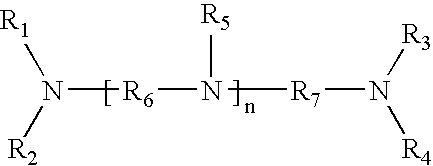Method of restoring catalytic activity to a spent hydrotreating catalyst, the resulting restored catalyst, and a method of hydroprocessing
a hydroprocessing and catalytic activity technology, applied in the field of hydroprocessing, can solve the problems of failing to teach presulfurization using elemental sulfur, failing to describe in anyway the presulfiding methodology, and failing to teach the revitalization of the catalyst using a chelation mechanism
- Summary
- Abstract
- Description
- Claims
- Application Information
AI Technical Summary
Benefits of technology
Problems solved by technology
Method used
Image
Examples
example 1
[0071] This Example 1 describes the three laboratory methods used to revitalize and restore catalytic activity to a commercially available hydroprocessing catalyst that had become spent through its use in the hydrotreatment of distillate feedstock.
[0072] Sample A was obtained by the burning of carbon from the spent hydroprocessing catalyst (the carbon burn may also be referred to as regeneration) followed by sulfurization. There was no intermediate chelation treatment or calcination prior to sulfurization of the regenerated spent hydroprocessing catalyst. Sample B was obtained by burning carbon from the spent hydroprocessing catalyst followed by a chelating treatment, drying and calcining prior to a sulfurization treatment. Sample C was obtained by burning carbon from the spent hydroprocessing catalyst followed by a chelating treatment and drying prior to a sulfurization treatment. There was no intermediate calcination of the chelant treated catalyst prior to the sulfurization.
[00...
example 2
[0089] This Example 2 describes the laboratory testing procedure and the feedstocks used to test the catalytic activity of the catalyst samples described in Example 1 relative to the catalytic activity of the fresh hydroprocessing catalyst.
[0090] The properties of the feeds used in the performance of the activity tests are presented in Table 1. To perform the activity tests, 50 cc of the relevant catalyst sample was placed in a test reactor operated under hydrotreating reaction conditions. The reaction conditions included a reaction temperature of about 360° C., total pressure of about 1650 psia, a feed rate such that the liquid hourly space velocity was about 1.5 hr −1, hydrogen-to-oil ratio of about 3700 SCF / bbl, and an operating time of about 400 hr.
TABLE 1Feed Properties Used in Activity TestsFEED PROPERTIESFEEDSulfur, wt %0.491Nitrogen, ppm1800Aromatics, wt %31.2Density @15.6° C.,0.946g / ccTBP (by GC)IBP (° F.)31710%47150%58790%691FBP790
[0091] The results of the activity test...
PUM
| Property | Measurement | Unit |
|---|---|---|
| time | aaaaa | aaaaa |
| temperature | aaaaa | aaaaa |
| weight percent | aaaaa | aaaaa |
Abstract
Description
Claims
Application Information
 Login to View More
Login to View More - R&D
- Intellectual Property
- Life Sciences
- Materials
- Tech Scout
- Unparalleled Data Quality
- Higher Quality Content
- 60% Fewer Hallucinations
Browse by: Latest US Patents, China's latest patents, Technical Efficacy Thesaurus, Application Domain, Technology Topic, Popular Technical Reports.
© 2025 PatSnap. All rights reserved.Legal|Privacy policy|Modern Slavery Act Transparency Statement|Sitemap|About US| Contact US: help@patsnap.com


